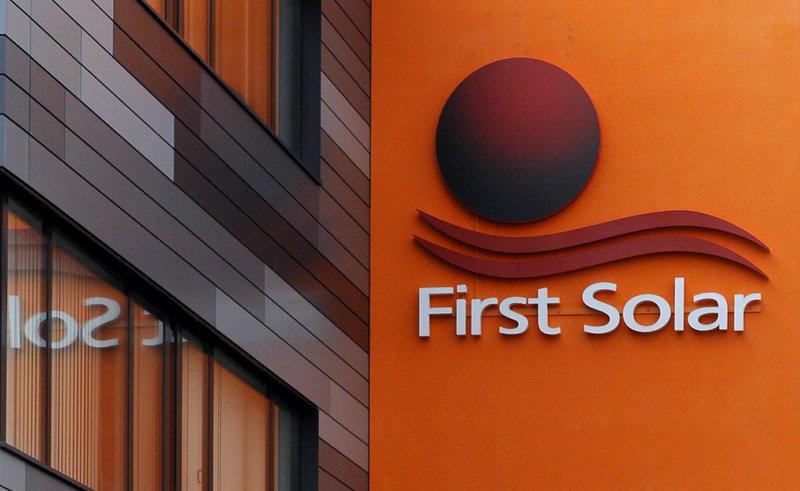NEW YORK – First Solar Inc.’s decision to fire 30 percent of its staff and reduce production shows that even the biggest solar-panel makers aren’t immune from the shakeout that’s bankrupted at least eight companies on two continents in the past year.
The largest thin-film solar producer said Tuesday it will cut 2,000 jobs by the end of the year at a cost of as much as $370 million. It marks the biggest staff reduction for the industry since bankrupt Solyndra, backed by U.S. government loans, dismissed its 1,100 employees Aug. 31.
Solar manufacturers, which expanded rapidly to meet double- digit demand growth in the past decade, are struggling with subsidy cuts in Europe and plunging natural-gas prices that make renewable energy less competitive. The largest producers in China say their profits will slump this year as shipments grow.
“Oversupply has become a problem for the entire industry,” said Ben Schuman, an analyst at Pacific Crest Securities in Portland, Ore. “China’s manufacturers have not demonstrated rational behavior.”
Solar panel prices have fallen 46 percent in the past year as manufacturers led by First Solar and Suntech Power Holdings, the world’s largest solar company, boosted output. Germany and Italy, the two biggest markets, are cutting rates paid for solar power to curb an uncontrolled installation boom.
Germany’s Q-Cells SE, once the world’s biggest solar-cell maker, filed for insolvency on April 3, becoming the fourth casualty in the country since December. Solon, Solar Millennium and Solarhybrid have all filed for insolvency as Germany cut incentives and China’s suppliers reduced prices.
They join Solyndra and three other U.S. solar companies that have failed since August — SpectraWatt, Evergreen Solar and Energy Conversion Devices.
Solar factories have expanded faster than demand and will be able to make as much as 38 gigawatts of panels this year, about 54 percent more than estimated demand, according to Bloomberg New Energy Finance.
That excess supply will arrive on the market as Europe’s largest economies, including Britain, Spain and France, follow Germany and Italy in scaling back incentives to curtail installation of power systems that are paid above-market rates.
“Demand is falling as governments, particularly in Europe, lose appetite for subsidizing the industry,” said Theodore O’Neill, an analyst at Wunderlich Securities.
The shifting support in Europe is particularly painful to First Solar because it favors rooftop power systems, which are more likely to use Chinese polysilicon panels. First Solar focuses instead on ground-mounted utility-scale plants that use its thin-film products, he said.
The U.S. Commerce Department, responding to complaints from U.S. solar manufacturers that Chinese competitors receive unfair government support, imposed tariffs last month of as much as 4.73 percent on panels made in China.
First Solar’s thin-film technology, which helped it become the lowest-cost panel manufacturer, generates less electricity than traditional polysilicon panels and doesn’t perform as well for rooftop installations that are widely used in Europe.
First Solar, based in Tempe, Ariz., said it will close its factory in Frankfurt an der Oder, Germany, in the fourth quarter. The company completed a $223 million expansion there in November that doubled production capacity to about 560 megawatts of panels a year. It will idle four production lines in Kulim, Malaysia, this month, with about 144 megawatts of capacity.
For China’s manufacturers, higher domestic demand may help offset falling sales in Europe.
“China will be a very, very important market in 2012,” Chen Kangping, chief executive officer of JinkoSolar Holding Co., said in an interview last week. “Some will gain share as others shut down.”
Jinko, based in Jiangxi, China, expects global shipments to rise 50 percent this year from 950.5 megawatts in 2011.
Send questions/comments to the editors.



Success. Please wait for the page to reload. If the page does not reload within 5 seconds, please refresh the page.
Enter your email and password to access comments.
Hi, to comment on stories you must . This profile is in addition to your subscription and website login.
Already have a commenting profile? .
Invalid username/password.
Please check your email to confirm and complete your registration.
Only subscribers are eligible to post comments. Please subscribe or login first for digital access. Here’s why.
Use the form below to reset your password. When you've submitted your account email, we will send an email with a reset code.